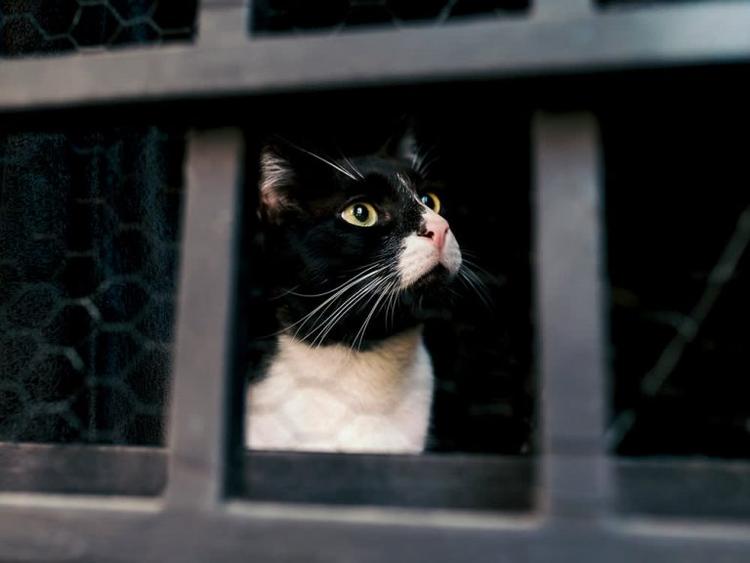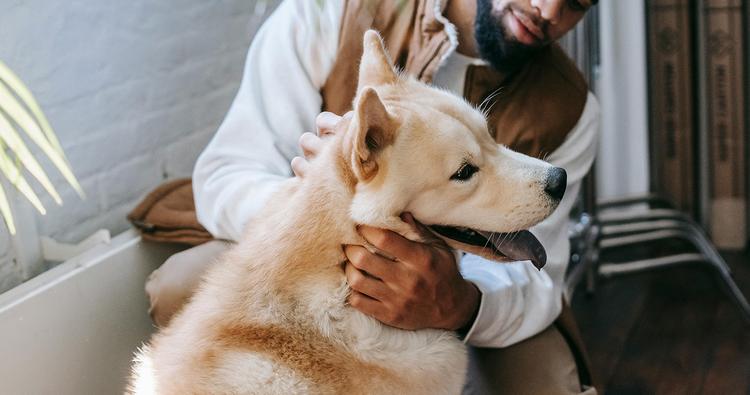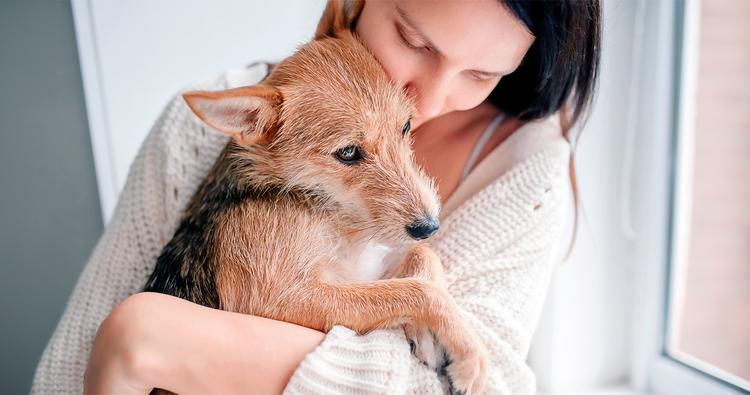by Alicia Kort, | January 8, 2024

We’ve all heard the euphemism “fight like cats and dogs,” but when it comes to canines and felines involved, we know that it can be a gross exaggeration. The internet provides plenty of proof of dogs raising kittens and cats snoozing on their dog pals, blind to the species difference. The reality is that all cats and dogs usually lie somewhere in the middle. Dogs used to be predators, so you can excuse your cat for being wary of this new, furry roommate. It’s instinct.
In this article:
That being said, you can’t just let your new dog prance into your cat’s domain and get up in their face. That’s a recipe for disaster. But how do you get those two different species to coexist under the same roof? That’s what we’re here to help with and we consulted Pam Johnson-Bennett, a cat behavior expert and author who has written eight books about cats. Johnson-Bennett runs Cat Behavior Associates, LLC, a private veterinarian-referred behavior company in Nashville. She helps shed some light on the introduction process and what to do when things aren’t going according to plan.
How can I help my cat get along with my dog?
First and foremost, it’s important to give your cat some grace and be patient, especially if your cat hasn’t been socialized with other species before. Introducing dogs and cats is easier if your cat was around dogs when they were a kitten. So, if your cat has never met a dog before in their entire life, it’s natural for your cat to be afraid and defensive.
Your kitty will need some time to adjust. Ensuring they have some of the same freedom and routines as they had before the pup will help the adjustment.
Give your kitty full run of the house at night. No doubt, as a cat parent, you’re used to them zooming around the house at 5 a.m. — they’re nocturnal and it’ll help reduce their stress levels if they’re able to get their energy out freely.
Dedicate one-on-one time with your cat. Your new pup will take up more of your time than usual, especially because you’re trying to get them adjusted to their new home, but it’s crucial to spend time with your cat — without your dog in the room. It’s like having a new younger sibling in the house; the eldest still wants time to hang out with their parents.
Can cats and dogs live in the same household?
Yes, cats and dogs can live in the same household, but it will be a big adjustment for both parties (especially your cat) and a time and effort commitment for pet parents. “Cats and dogs can be great friends, but it’s essential to do a safe and positive introduction,” Johnson-Bennett says. “Some dogs who have been allowed to chase small animals may chase the cat and that will create fear and put the cat in danger. Before deciding to add another pet, make sure to take time to evaluate your current pet’s personality and needs so you can determine if the addition will benefit your resident pet’s life and if you have the time to do the proper training.”
How to Introduce Cats to Dogs
The first meeting is like a first impression during a job interview or first date. It’s very important. If it’s bungled or goes badly, it might take your cat a long time to warm up to your dog — and even then, they might not feel totally at ease. We highly recommend following these steps to introduce your cat to a new dog:
1. Keep your cat and your new dog separate at first.
“The first step is to set the dog up in a separate room as a sanctuary so they can adjust to this totally unfamiliar environment,” Johnson-Bennett says. “This also gives you time to bond and get to know the dog. When you feel the dog has comfortably settled in, you can begin a slow, safe, and positive introduction to the cat.”
When a new dog is being introduced in a house where your cat is already comfortable, your cat may feel as if their home is being infringed on. “The cat needs to know that their territory is safe so keep the dog in a confined area as you do the training and introduction.” (If a dog is the current resident, you should confine the cat first instead of the dog.)
This might involve rearranging your space a bit to accommodate this transition. In order for your cat to feel as secure as possible in the home, there should be rooms where the dog is not allowed in and places where the dog can’t reach the cat. “The home should be set up so the cat always has safe areas that are dog-free zones,” Johnson-Bennett says. “This includes the litter box area, sleeping area and feeding station. You don’t want the dog sticking a nose in the litter box and disturbing the cat, so ensure the litter box area is safe. An easy way to do that is with a baby gate with a small opening in it for the cat to get through. A cat tree is also a good investment so the cat always has an elevated area to escape for safety.”
We also recommend feeding the cat and dog at the same time with the door in between them. This will give them time to get used to each other’s scents and associate them with a positive experience.
2. Introduce them through a barrier.
If your cat is still hiding, introduce them through a glass door, window, or gated barrier. The cat will feel more secure and it’ll allow them to observe the dog safely without fear.
“The cat must feel comfortable being visible,” Johnson-Bennett says. “If the cat is so scared that they’re hiding under the bed or in the closet, then you need to go more slowly. What’s important is that the cat, throughout the entire introduction process, always has the freedom to leave the room, climb to an elevated spot, or hide. Having that control is critical to reducing the cat’s stress.”
3. Begin controlled face-to-face meetings.
Don’t let an off-leash pup approach your cat — they’ll be scared and won’t forget the experience. “When you first start the introduction process, the dog should be on a leash so you can control their movements,” Johnson-Bennett says. “Reward the dog when they focus on you and don’t stare at the cat. If you just let the dog run up to the cat, kitty will surely give a swipe and run in fear. Control the movements of the dog and teach that a relaxed body posture will be rewarded.”
4. Give them a bit more freedom.
When your cat seems at ease and your dog continues to remain in a calm position, after several sessions, you can drop the dog’s leash, but keep it within arm’s reach and give your cat an escape route.
What does “at ease” look like for a cat? “I look for a relaxed posture,” Johnson-Bennett says. “The cat may not want to snuggle up next to the dog but if kitty is comfortable enough to not stare endlessly and can engage in normal behaviors, such as napping, grooming, eating, or playing, then that’s a huge step in the right direction.”
But just because the introduction is finished doesn’t mean that your pets are the best of friends yet. “Don’t let the cat and dog be together unsupervised until the training has been completed and you are 100 percent certain both animals are safe together.”
What is a cat safe zone?
“A [cat] safe zone is any location that is essentially dog-free,” Johnson-Bennett says. “During the introduction period it’s important to provide the cat with areas where they can get away from the dog. A cat tree, window perch, litter box in a room with a baby gate, elevated or separate feeding station, undisturbed napping areas, and so on, are critical. Even after the cat and dog become best buddies, there are areas where the cat can always go undisturbed.”
Also make sure that the cat’s food is secure — cats don’t like sharing food and may become territorial if they find the dog sniffing around their food and water bottles.
FAQ
How long does it take for a cat to get used to a dog?
Don’t put pressure on your animals to conform to a specific timeline. If you’re already a cat parent, you know that cats do things when they want to do things and if anything, will deliberately do what a person tells them not to do. You’re only going to get unfairly frustrated toward your pets.
“There is no set time for when/if a cat and dog will get along,” Johnson-Bennett says. “Much of it depends on how the animals were socialized, their ages, past experiences, and the training method used.”
Should I consult a professional if the problems persist?
If you don’t feel that the relationship is progressing smoothly, a behaviorist or trainer may be able to help you take a step back and assess the situation. “Identify what specifically is causing fear or is creating a roadblock in the relationship so you can adjust the environment or tweak the training accordingly,” Johnson-Bennett says. “The two biggest mistakes I see pet parents make are that they rush the process and they punish [them] for unwanted behavior. The approach to take is to go gradually and give them a reason to like each other.”
Consulting a professional can help keep you on track. “There is nothing more important than the safety of both animals,” Johnson-Bennett says. “If you are worried that one or both will get injured, or if you see serious aggression, then you need to separate them immediately. Your veterinarian can refer you to a professional trainer or certified behavior expert.”
What if my cat still refuses to accept the dog?
If you sought out a professional and it did not help (or you are unable to make the investment in helping your cat with their behavior problems) you may need to consider rehoming. Rehoming your new dog to a family that can better address these needs may be a very kind and responsible choice. Rehome is a peer-to-peer adoption service that allows pet parents to post their pets on Adopt a Pet to be seen by millions of potential adopters.
A safe, reliable way to rehome your pet
Get Started
Alicia Kort
Alicia Kort is a writer and editor living in Brooklyn. She’s currently the senior commerce editor at Apartment Therapy. She’s been published in StyleCaster, Electric Literature, Newsweek, Interview, Brooklyn magazine and more. In her free time, she runs, reads, and spends time with her dog-nieces, Maya and Lady, and her cat-niece, Pepper.
Related articles

Behavior & Training
Why Is My New Cat Hiding?

Behavior & Training
How Do I Get My Cats To Like Each Other?

Behavior & Training
How Long Does It Take for a Cat to Get Used to a New Kitten?

Behavior & Training
How Long Does It Take For Cats To Get Used To Each Other?

Behavior & Training
How Do I Get My Older Cat to Like My New Kitten?

Adoption Advice
Adopting a Cat? Here’s How to Prepare Your Home for a New Kitty
Ready to welcome a new feline friend? Here’s how to make sure your home is ready for their arrival.

Adoption Advice
How to Introduce a New Puppy to Your Dog
Adopting a new puppy can shake-up the doggy dynamics at home. Here’s how to keep the peace and harmony among your pets.

Behavior & Training
Why is My Cat Suddenly Aggressive Toward Other Cats?

Adoption Advice
First Day Home with a Puppy? Here’s What to Expect
The beginning of puppy parenthood can be rough, but it does get better — especially when you implement this advice.

Rehome
The 5 Top Reasons Cats Are Taken to Shelters (And How to Prevent Surrendering Them)
Nobody wants to part with their beloved pet — and you don’t have to. Here are some practical solutions to consider before assuming your cat isn’t working out.

Adoption Advice
Introducing a New Cat Too Soon: Troubleshooting Common Issues
Cat introduction process not going well? Here’s what might be causing the issues.

Adoption Advice
How to Introduce a Cat to a Dog? 6 Essential Steps
Navigate the process of introducing pets with ease using our expert guide on creating a harmonious bond between your pets.

Adoption Advice
Things I Wish I Knew Before Getting a Second Cat
Thinking about adding another cat to your home? Here’s how to expand your family, minus the drama.
Behavior & Training
How to Get a Dog to Like a Cat: Tips and Instructions

Adoption Advice
The 3-3-3 Rule For Dogs: Adopted Dog Adjustment Period Explained
Find out how to set your adopted rescue dog up for success.

Rehome
Rehome My Pet: How to Find a Home For My Pet
If you’re considering finding a new home for a pet, check out Rehome. It’s Adopt a Pet’s safe, simple program that lets people safely rehome a pet.


Rehome
How Do I Rehome My Dog?


Adoption Advice
Pet Classifieds: A Better Way to Rehome a Pet
Help us in our mission to rehome pets safely. Join us in keeping pets secure and away from classified sites.





Rehome
Does Kriser’s Take Cats?


Rehome
Does Mud Bay Take Cats?


Adoption Advice
How to Spot a Pet Adoption Scam
Falling victim to a pet scam is bad for you and the animals whom scammers are trying to sell. Here’s how to avoid them.


Rehome
Does Petland Take Cats?


Rehome
Does Petco Take Cats?


Rehome